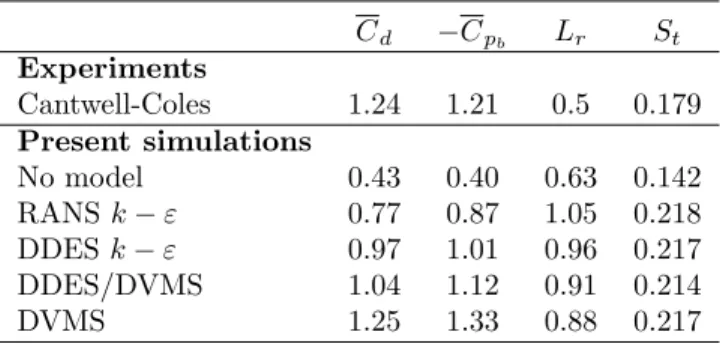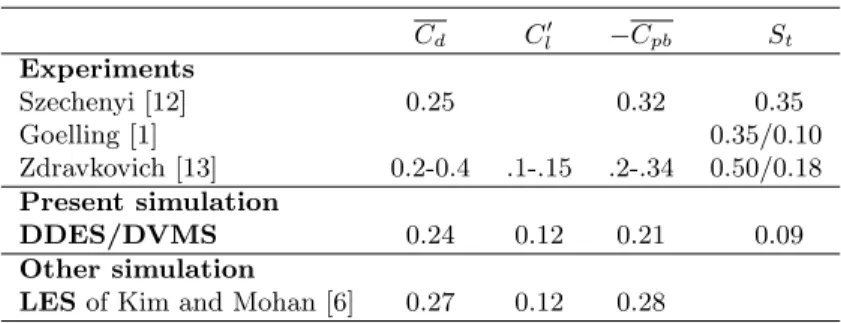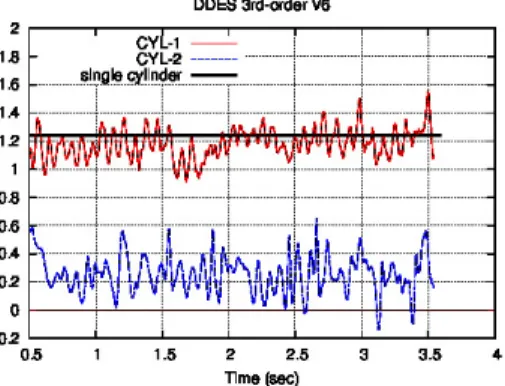HAL Id: hal-01928383
https://hal.inria.fr/hal-01928383
Preprint submitted on 21 Nov 2018HAL is a multi-disciplinary open access archive for the deposit and dissemination of sci-entific research documents, whether they are pub-lished or not. The documents may come from teaching and research institutions in France or abroad, or from public or private research centers.
L’archive ouverte pluridisciplinaire HAL, est destinée au dépôt et à la diffusion de documents scientifiques de niveau recherche, publiés ou non, émanant des établissements d’enseignement et de recherche français ou étrangers, des laboratoires publics ou privés.
Combining a DDES model with a dynamic variational
multiscale formulation
Emmanuelle Itam, Stephen Wornom, Bruno Koobus, Alain Dervieux
To cite this version:
Emmanuelle Itam, Stephen Wornom, Bruno Koobus, Alain Dervieux. Combining a DDES model with a dynamic variational multiscale formulation. 2018. �hal-01928383�
Preprint 2018
COMBINING A DDES MODEL WITH A DYNAMIC
VARIATIONAL MULTISCALE FORMULATION
Emmanuelle Itam1, Stephen Wornom2, Bruno Koobus1, Alain Dervieux2,∗ 1 IMAG, Univ Montpellier, CNRS, Montpellier, France, emmanuelle.itam@umontpellier.fr,
Bruno.Koobus@umontpellier.fr
2 Soci´et´e technologique LEMMA, 2000 route des Lucioles, Sophia-Antipolis, France, and
Institut National de Recherche en Informatique et en Automatique (INRIA), 2004 Route des lucioles, F-06902 Sophia-Antipolis, stephen.wornom@inria.fr, alain.dervieux@inria.fr
∗ Corresponding author.
Abstract: This paper studies the improvement of DDES models by locally replacing the LES-like component with a Dynamic Variational Multiscale model. Improvements are measured for flow around cicular cylinders at Reynolds numbers ranging from 20000 to 1 million and for tan-dem cylinders (from a distance between the cylinders of 3.7 diameters up to 12 diameters). Keywords: turbulence, RANS, DDES, hybrid RANS/LES, Variational Multi-scale, cylinder, tandem
Introduction
From the beginning of turbulence modelling, researchers have tried to find a universal model which they could propose to engineers. Today, hybrid RANS/LES models, among them DDES models, attempt to obtain higher universality by applying different theories (statistics, filters) in different regions of a complex flow. This quest for universality is illustrated in the litterature by applications of these models to a large set of turbulent flows. For the assembly of such composite models, the first difficulty is to a priori identify which part of the flow is best suited to each model. A second difficulty is to choose the models to combine, in particular, to choose which model in a given category (RANS, LES). The DDES method answers the first question and has been adopted by many teams. Concerning the RANS model to combine, the Spalart-Allmaras model, has often been replaced by a two-equation closure, like k − ω. Indeed, it is expected that the many improvements performed on the latter sophisticated RANS closure will have a positive influence on the predictivity of the final model. DDES involves a LES-like model, based on the turbulent viscosity, which is controlled indirectly by a measure of local mesh size. The turbulent viscosity then acts as a Smagorinsky viscosity. When the viscosity coefficient is too low, this model is equivalent to no modelling. We shall show in the sequel that this is not the best model. When the viscosity coefficient is too high, this introduces a too high damping and this results in a bad modelling. When the viscosity coefficient is of convenient strength, it keeps the usual disadvantage of damping large scales, the dissipative effects of the unresolved scales being taken into account on all resolved scales (small and large), which results in a too low backscatter in the simulation. Several LES models behave in most cases better than a baseline Smagorinsky model, while staying very simple (no extra equation). Among them, the dynamic subgrid-scale (SGS) model and the variational multiscale approach which is aimed at limiting the effects of the SGS closure model to the smallest resolved scales. In [4] we define DVMS, a combination of both models which is not computer intensive and, at the same time, produces better prediction for the test cases we tried.
The focus of this work is two fold. First, to investigate the possible improvement of a DDES when we locally replace the LES-like component by DVMS. Second, to evaluate DDES as a quasi-universal tool, where quasi-universal in our case will more modestly restrict to a small collection of cylinder/tandem flows with a range of Reynolds numbers corresponding to a sub-critical flow regime for the isolated cylinder or the first cylinder in the tandem problem, as well as a case of supercritical cylinder flow.
Modelling
The main ingredients adopted in our modelling platform are the following ones. As RANS component, we use the Goldberg-Peroomian-Chakravarthy [2] low Reynolds k-eps model which improves near-wall flow predictions, in particular the predictive capabilitiy of adverse pressure gradient flows, compared with more traditional k-eps models. This RANS model is integrated inside a DDES formulation in a similar way to what is done with several k − ω RANS, see for example [3]. As concerns the LES component, previous investigations [4] show that our DVMS model, which combines a Germano-type dynamic SGS model with a variational multi-scale formulation, gives good predictions for a low computational cost (model of low complexity with a good predictivity on rather coarse meshes). Our focus is the action of DVMS in the wakes after the blunt bodies. In the present study, we restrict our work to cylindrical geometries and we locally apply DDES to the region defined as points located at a distance from the cylinder less than 20% of the cylinder radius, DVMS being otherwise applied. Although this combination is zonal and rather simple, this allows to evaluate the effects on the flow prediction of the application of DVMS in the wake region, instead of the LES-like mode of DDES. We call DDES/DVMS the resulting model. As for the numerics, a second-order accurate scheme stabilized by a tunable numerical diffusion proportional to sixth-order space derivatives is used. Numerical experiments Cd -Cpb CLrms Θsep Lr St Experiments Norberg [5] 1.16 1.16 0.47 78 1.03 0.194 Present simulations No model 1.27 1.35 0.61 82 0.96 RANS k − ε 1.31 1.49 0.75 85 0.50 0.212 DDES k − ε 1.25 1.21 0.58 86 0.90 0.194 DVMS 1.18 1.20 0.46 81 0.96 0.196 DDES/DVMS 1.17 1.13 0.46 82 1.05 0.200
Table 1: Bulk flow parameters for Re = 20000 flow around a cylinder. The mesh involves 1.8M vertices. Cd is mean drag, Cpb is pressure coefficient at base, C
rms
L is lift rms, Θsep is the separation angle, Lris
recirculation length, St is Strouhal number, Θsep is the separation angle.
Cylinder flows have been studied and measured for at least half a dozen decades. Although many measurements are available in the litterature, it remains difficult to identify from them accurate estimates of the bulk coefficients. Computations also are difficult in that the predictions of bulk coefficients are relatively error-prone, even for Reynolds numbers relatively far from the drag crisis interval. However, these bulk coefficients are the main expected output in engineering studies.
Low Reynolds number calculations
The DES and DDES models have been introduced for addressing flows in which the boundary layer is turbulent. In principle, the flow around a cylinder at Reynolds number 20K, which is known as presenting laminar boundary layers, should not be computed with DDES. In all our calculations, RANS and DDES adimensioned inflow conditions (unit reference length and velocity) for k and ε are k = 5 × 10−5 and ε = 5 × 10−6 in such a way that the turbulent viscosity is µt= 4.5 × 10−5. Of course the RANS model diminishes this viscosity level according
to turbulence decay. The decreasing is accelerated by the DDES model at about 2.5 diameters before the stagnation point. The DDES viscosity becomes about 10 times smaller than for RANS in the boundary layer. Therefore the laminar boundary layer is not too badly addressed by DDES. Moreover, this DDES viscosity becomes really small in the wake, but of Smagorinsky type. Bulk coefficients are given in Table 1. It appears DDES works really better than RANS, but that locally substituting the LES-like component of DDES by DVMS brings a rather sensible improvement.
Flow near criticality
In Table 2 we examine the impact of the turbulence model on the prediction of a still subcritical flow around a cylinder at Reynolds number 140K. Assuming that the incoming flow is laminar, the boundary layer should also be laminar. A RANS model will represent a turbulent boundary layer and will also spuriously damp the turbulent wake. As a result, the bulk coefficients do not
Cd −Cpb Lr St Experiments Cantwell-Coles 1.24 1.21 0.5 0.179 Present simulations No model 0.43 0.40 0.63 0.142 RANS k − ε 0.77 0.87 1.05 0.218 DDES k − ε 0.97 1.01 0.96 0.217 DDES/DVMS 1.04 1.12 0.91 0.214 DVMS 1.25 1.33 0.88 0.217
Table 2: Bulk quantities for Re = 140000 flow around a cylinder. The mesh involves 0.9M vertices.
agree well with experiments. The behavior of the DDES model is now very similar to RANS in the boundary layer but very different in the wake. We observe a notable positive improvement of the prediction. This improvement is further amplified by DDES/DVMS, but not enough to get a model as good as DVMS.
Supercritical flow
The Reynolds number is now 1 million. Mean coefficients were long to obtain and only the DDES/DVMS result is presented. We expect to present also the DDES calculation in our talk. We then compare our calculation to experiments and to a LES calculation by Kim and Mohan using 6.8M cells. For this test case two Strouhal numbers have been experimentally observed but with the present mesh, the DDES/DVMS computation predicts only the smaller one.
Cd Cl0 −Cpb St Experiments Szechenyi [12] 0.25 0.32 0.35 Goelling [1] 0.35/0.10 Zdravkovich [13] 0.2-0.4 .1-.15 .2-.34 0.50/0.18 Present simulation DDES/DVMS 0.24 0.12 0.21 0.09 Other simulation
LES of Kim and Mohan [6] 0.27 0.12 0.28
Table 3: Bulk coefficients of the flow around a circular cylinder at Reynolds number 106. The mesh
involves 2.85M vertices.
Tandem cylinders with 3.7D distance
We now consider a tandem cylinder with a separation distance of 3.7 diameter. This test case is particularly challenging and useful for understanding particular flows in aeronautics. First, the flow over the first cylinder has to be correctly predicted, second the turbulent wake betwen the two cylinders has to be well captured, which of course conditions the quality of the prediction of the flow around the second cylinder. This implies to be able to have not too dissipative turbulence and numerical models, as well as an appropriate grid.
Mesh C d1 Cd 2 CLrms 1 CLrms 2 Experiment
Neuhart and Lockard [8] 0.64 0.31
Present simulations
RANS 2.59M 0.55 0.24 0.01 0.32
DDES/DVMS 2.59M 0.64 0.38 0.077 0.79
Other simulations
DES k − ω SST, Aybay [9] 6.7M 0.64 0.44
S-A DDES, Garbaruk [10] 11M 0.48 0.42 0.078 0.612
Table 4: Tandem cylinder with 3.7D distance at Re = 166000: mean drag coefficient and root mean square of the lift time fluctuations. Circled superscripts hold for cylinder 1 and cylinder 2.
In Table 4, we compare bulk coefficients obtained in our RANS and DDES/DVMS simulations with those of Aybay [9] and Garbaruk [10], and measurements by Neuhart [8]. We observe that the RANS model gives rather poor predictions while the results obtained with the DDES/DVMS model are in overall good agreement with experimental data, although the prediction is less accurate for the second cylinder. It should also be noted that the DES and DDES results of Aybay and Garbaruk on finer meshes compare less well with experimental data.
As an example of distribution of a quantity of interest, that of the turbulent kinetic energy (TKE) predicted by the DDES/DVMS model along the wake centerline in the gap between the two cylinders is depicted in Figure 1, which shows a good agreement with BART experimental data.
Tandem cylinders with large distance
The accurate modelling of the wake is even a more important issue when the calculation is applied to the analysis of the interaction between two aligned cylinders with a rather large
Figure 1: Distribution of the resolved TKE along the wake centerline in the gap between the two cylinders for the DDES/DVMS computations (continuous line).
distance between them. This kind of flow are encountered when studying interaction between risers in water [11]. In the case which we study, this distance is 12 diameters. The mesh (8M vertices) is designed in order to be a Cartesian one in most part of the interval between the two cylinders. This is done for enjoying the superconvergence (up to order 5) of the numerical scheme. In this region the DVMS applies and preserves as much as possible the medium scales of the flow. As a result, the influence of the first cylinder is accurately propagated and causes a 5-6 times smaller drag on the second one (Figure 2). A detailed study of the impact of the wake model on important quantities (in particular turbulence intensity which was observed as very sensitive to the LES model in other cases) will be presented at the conference.
Figure 2: Flow around a tandem cylinder with an inter-cylinder distance of 12 diameters and a Reynolds of 140K. Drag history for both cylinders (in black, mean drag of a single cylinder).
Concluding remarks
In this work, a zonal combination of DDES and DVMS is investigated for the flow prediction around cylinders and tandem cylinders at various Reynolds numbers. This first study tends to show that the application of DVMS in the wake region instead of the LES-like mode of DDES has a positive impact on the considered flow predictions. Compared to more simple LES models, the DVMS model in which the dynamic SGS procedure and the variational multiscale formulation work in a complementary way, allows for a more accurate simulation of unsteady turbulent wakes, resulting in an improved prediction of the global flow. Nevertheless, further investigations need to be done in order to confirm this tendancy. Other flow problems will be considered (backward facing step, channel flow), and a non-zonal combination of DDES and DVMS is also under investigation.
REFERENCES
[1] B. Goelling. Experimental investigations of separating boundary-layer flow from circular cylinder at Reynolds numbers from 105 up to 107; three-dimensional vortex flow of a circular cylinder. In G.E.A. Meier and K.R. Sreenivasan, editors, Proceedings of IUTAM Symposium on One Hundred Years of Bloundary Layer Research, pages 455–462, The Netherlands, 2006. Springer.
[2] U. Goldberg, O. Peroomian, and S. Chakravarthy. A wall-distance-free k − ε model with enhanced near-wall treatment. Journal of Fluids Engineering, 120:457-462, 1998.
[3] M.S. Gritskevich, A.V. Garbaruk, J. Schultze, and F.R. Menter. Development of DDES and IDDES formulations for the k − ω shear stress transport model. Flow, Turbul. Combust. 88, 431449, 2012.
[4] C. Moussaed, S. Wornom, M.V. Salvetti, B. Koobus and A. Dervieux. Impact of dynamic subgrid-scale modeling in variational multiscale large-eddy simulation of bluff body flows. Acta Mechanica, 12 , 3309-3323, 2014, DOI 10.1007/s00707-014-1112-6.
[5] C. Norberg. Fluctuating lift on a circular cylinder: review and new measurements. J. Fluids Struct., 17:5796, 2003.
[6] S.-E. Kim and L.S. Mohan. Prediction of unsteady loading on a circular cylinder in high Reynolds number flows using large eddy simulation. Proceedings of OMAE 2005: 24th In-ternational Conference on Offshore Mechanics and Artic Engineering, june 12-16, Halkidiki, Greece, OMAE 2005-67044, 2005.
[7] P. Spalart, S. Deck, M. Shur, K. Squires, M.K. Strelets, and A. Travin. A New Version of Detached-Eddy Simulation, Resistant to Ambiguous Grid Densities. Theoretical and Com-putational Fluid Dynamics, 0935-4964, pp.181-195, July 2006.
[8] D. Neuhart, L. Jenkins, M. Choudhari and M. Khorrami. Measurements of the flowfield interaction between tandem cylinders, AIAA Paper, 2009-3275, 2009.
[9] D. P. Lockard. Summary of the Tandem Cylinder Solutions from the Benchmark Problems for Airframe Noise Computations-I, Proceedings of Workshop AIAA, AIAA-2011-353, 2011. [10] A. Garbaruk, M. L. Shur, M. Strelets, P. R. Spalart and R. Balakrishnan. DDES and IDDES of Tandem Cylinders, Proceedings of the Benchmark problems for Airframe Noise Computations, BANC, volume anl-10/26, Argonne National Laboratory, 2010.
[11] V. Levasseur, C. Leca, F. Petrie, B. Rousse. Basin Tests and Numerical Simulations of Wake-Induced Oscillations of Inline Risers in Subcritical/Critical Regime Proceedings of the ASME 2018 37th International Conference on Ocean, Offshore and Arctic Engineering, OMAE2018, June 17-22, 2018, Madrid, Spain, OMAE201877842, 2018.
[12] E. Szechenyi. Supercritical Reynolds number simulation for two-dimensional flow over circular cylinders. J. Fluid Mech., 70:529–542, 1975.
[13] M.M. Zdravkovich. Flow around circular cylinders Vol 1: Fundamentals. Oxford University Press, 1997.



